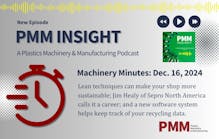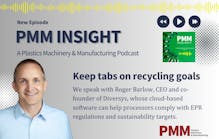This commentary appears in the summer 2021 issue of Plastics Recycling. Read more from the issue.
By Ron Shinn
The announcement in June that 95 major brand owners and other organizations have agreed on a strategy to achieve a circular economy for plastic packaging sounds like good news for the recycling industry.
“The roadmap is designed to help U.S. industry leaders act on the significant, system-wide change needed to realize a circular economy for plastics by 2025,” said Emily Tipaldo, executive director of the U.S. Plastics Pact. The U.S. Plastics Pact is a consortium led by the Recycling Partnership and World Wildlife Fund as part of the Ellen MacArthur Foundation.
It is certainly good news when Coca-Cola Co., Target, Walmart, Unilever, Clorox, Mondelez and other big brands get behind a recycling plan. But I feel like we have heard much of this before, so pardon my skepticism.
Companies that sell resin with recycled content cannot meet the current demand. Indianapolis-based Plastic Recycling Inc. is running a new sorting line for electronic shredded residue just four days a week because it cannot find labor to run the line for seven days. Kal-Polymers in Mississauga, Ontario, was quoted in our last issue as saying resin demand is strong and total capacity is sold out.
Achieving a significant increase in the amount of plastic packaging being recycled faces a dizzying array of challenges: Some communities think plastic bans are needed and others do not want to pay to recycle the plastics they already collect; governments, from local city councils to Congress, appear to lack the will to invest time and money in recycling; recycled resin is in demand because virgin resin prices are high, but will drop again, and investment money does not like that sort of uncertainty in resin markets.
Perhaps most troubling is the negative perception of plastics. It may soon be too late to reverse the downward spiral of plastic-is-bad thought. At some point, those who want to ban all plastics may be in the majority.
The Plastics Pact has lofty goals for 2025:
Define problematic or unnecessary packaging by 2021 and take measures to eliminate it;
Make 100 percent of plastic packaging reusable, recyclable or compostable;
Recycle or compost 50 percent of plastic packaging;
Achieve 30 percent bio-based content in recycled packaging.
The U.S. recycles about 14 percent of its plastic packaging. I do not believe we can get from 14 percent to 50 percent in the next 1,200 days.
Can a voluntary effort like this make a difference? I hope so. The entire recycling value chain has a big stake in making real progress towards a circular economy for plastics. Go online and read the report and decide how you can help.
“To meaningfully address the plastic waste crisis in the United States, we must unite the critical stakeholders — industry leaders, waste management systems and policy makers — under a cohesive action plan,” said Erin Simon, head of plastic waste and business at the World Wildlife Fund, in a news release announcing the Plastics Pact.
I’ll keep my fingers crossed.
Ron Shinn, editor
Ron Shinn | Editor
Editor Ron Shinn is a co-founder of Plastics Machinery & Manufacturing and has been covering the plastics industry for more than 35 years. He leads the editorial team, directs coverage and sets the editorial calendar. He also writes features, including the Talking Points column and On the Factory Floor, and covers recycling and sustainability for PMM and Plastics Recycling.






